Hübner offers new steering system in buses to revolutionize passenger transport in cities
By Jim Gibbins - 12th September 2022
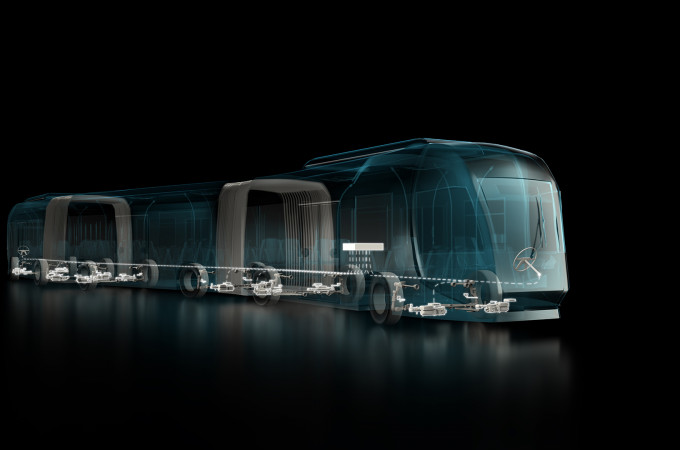
High Capacity Bus with Hubner Steering System
Germany - Hübner GmbH & Co. KG (Hübner Group) of Kassel, Germany has developed a new advanced electronically controlled steering system to enable OEMs to build and deliver a completely new concept in high capacity passenger transport; a new bi-articulated bus or trackless vehicle capable of being 36 metres in length, of carrying 300 passengers at a time and, most significantly, being able to operate on normal roads without the need for special lanes, tracks or guidance systems.
The new steering system is called the Hübner Articulated Bus Steering Control (ABSC) system. The concept of which was established some eight years ago when Hübner, a supplier of articulation systems in the bus, tram, light and heavy rail vehicle sectors, started to consider combining the high capacity advantages of tram and light rail systems with the flexibility and lower cost advantages of buses. Hübner stated that due to the rapidly evolving developments in electric drive concepts and their integration in various vehicle types, what seemed physically and economically impossible just a few years ago, was now possible.
The importance of electrically driven multiple axles in development of the steering control system
In an interview with T&BB about the Hübner ABSC system, Uwe Bittroff, responsible for Bus at Hübner Technologies, emphasised that a key turning point had been the availability of the electric buses with electric motors on multiple axles. He said the longer the bus the more important it is that it follows an invisible track whereby the middle and the rear of the articulated bus follows the exact same route taken by the front of the vehicle to avoid colliding with other vehicles. For this to happen, one needs to develop an intelligent multi-axle steering system, stated Bittroff.
Bittroff provided a diagram (see below) showing the simulations of turning circles and routes of two articulated buses with different axle specifications. Simulation of a bi-articulated bus with three steered-axles shows a turning circle where the width of the road needs to be 10 metres wide for the extended bi-articulated bus to conduct a full circle, whereas one with six steered axles, shows a bi-articulated bus navigating a full circle on a road just 4 metres wide, whilst at the same time and most importantly, staying within the width of the road. However, Bittroff said that to be able to develop a flexible system as possible, it was necessary to conduct many simulations looking at different combinations of steered driven axles and steered axles, to provide a modular approach as possible to match different applications.
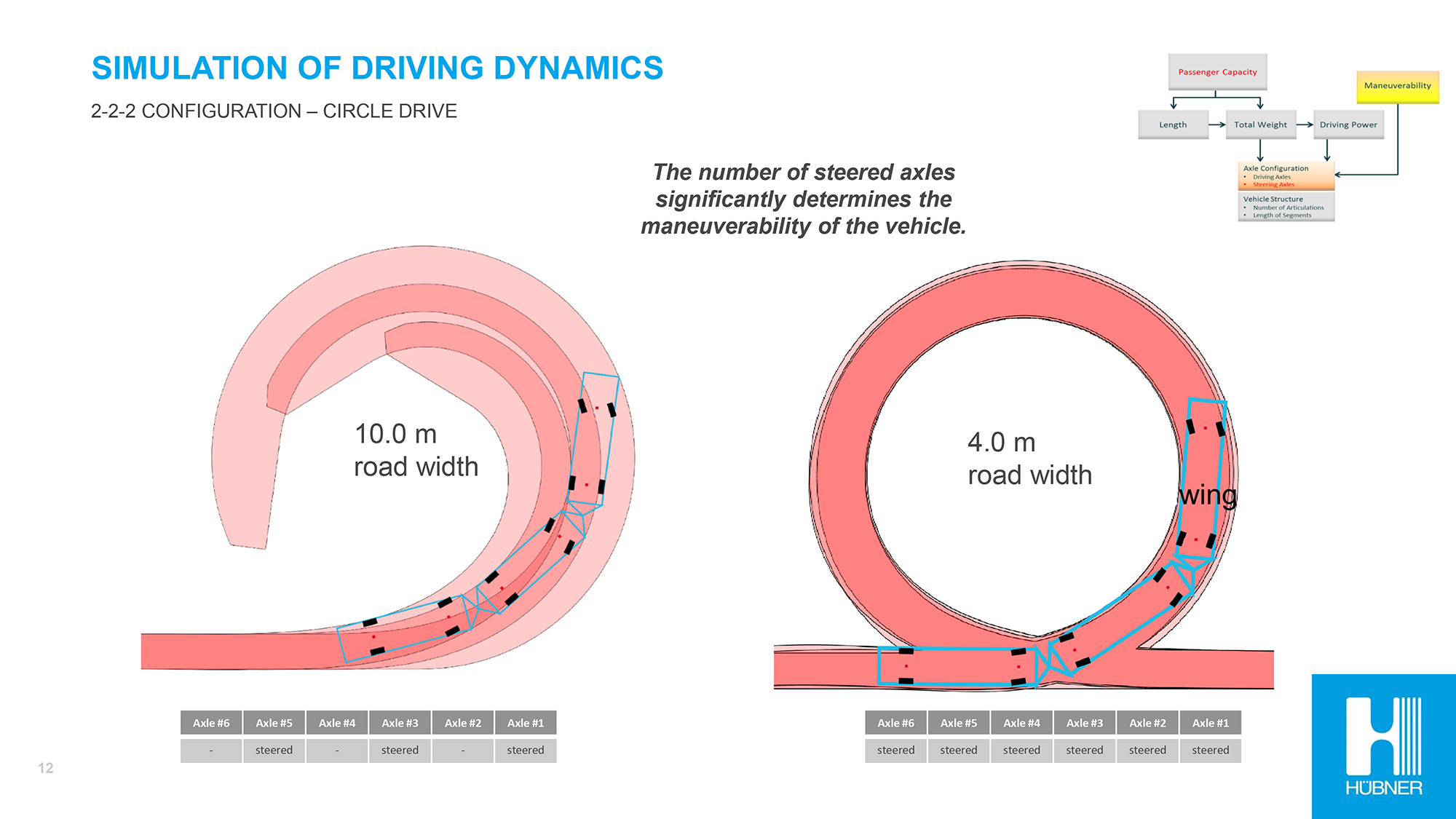
Hübner simulation diagram comparing the turning circle alignment of 3-steered axles and 6-steered axles in HCBs
Hübner’s partnership with the Fraunhofer Institute for Transport and Infrastructure
Hübner said the key technical challenge of the project had been to replace a tram's traditional rail-based guidance system with a safe and dependable steering technology that functioned without rails and that could control a multi-element six-axled vehicle.
Hübner said it had been working together with the Fraunhofer Institute for Transport and Infrastructure Systems IVI1 on the Hübner ABSC (Articulated Bus Steering Control) system since 2014. (Bittroff explained that Hübner has been working with the Fraunhofer Institute because of its expertise and long experience of developing algorithms for steering systems for multi-axle buses – starting with the Gopple AutoTram three multi-axle steering project in 2005. Hübner was also part of this project in development of the articulation gangways). Hübner, together with the Fraunhofer Institute, subsequently produced prototype concept vehicles with four different Chinese manufacturers; three bus builders and one light railcar manufacturer – Chinese builders were selected due to their earlier adoption of battery-electric vehicles. In 2017, Hübner took over the project management of the steering system. Through this experience of these prototype projects in China, Hübner said the steering behaviour for the new vehicle concepts were tested successfully and that with these prototypes it had been possible to show the basic functionality of the steering system on demonstration courses. Below is a picture showing the various proof of concept prototype projects involving Hübner since 2012.
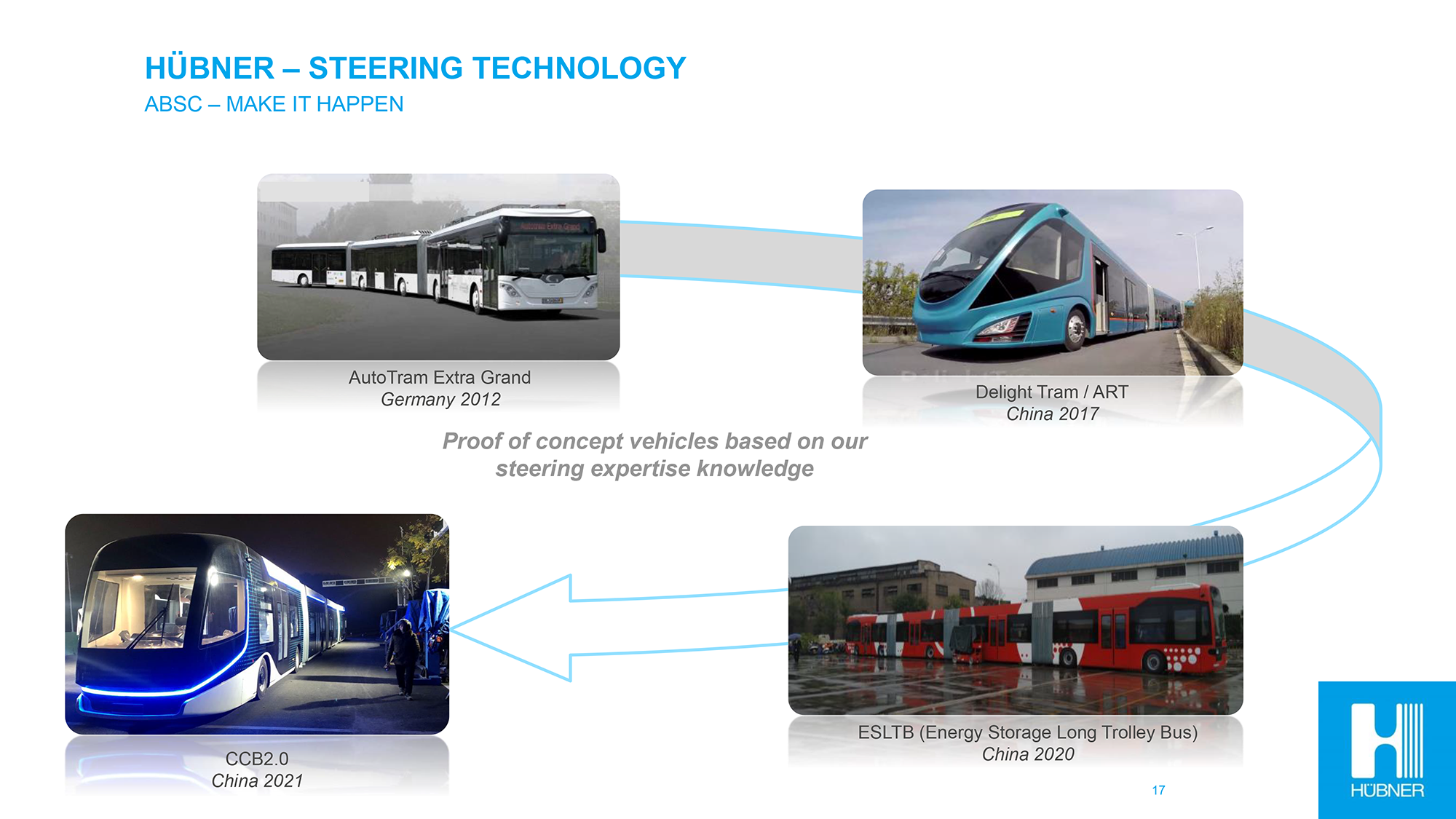
Proof of concept vehicles based on Hübner steering knowledge and expertise
The difference between what Hübner offered in these prototypes was the failsafe system. In all the prototype systems, the master unit was setting and sending the information directly to every axle, whereas with the ABSC system being offered today, every axle is controlled independently with its intelligent safety system – see more details below.
Investment in the steering technology – Business model
As with many inventions, there is always the question of whether there is the business case for investment and in bringing such as a new and radically advanced steering system to market. Here, Bittroff said there is, most definitely, a growing demand for High Capacity Buses (HCB) arising from the trend of the rail industry in urban areas, with tram vehicles being combined with the rubber tyre technology of buses. He sees that HCB offers cities in the future, a high capacity and ride quality at a low cost and without the high level of disruption to the city during implementation, as is the case most often with trams or light rail systems.
However, a key issue is the development project cost to a bus OEM, stated Bittroff. It is not economic for a bus manufacturer to invest in an advanced steering system for just 20 or 30 buses, and furthermore, Bittroff continued, the time is often not enough to just develop it for just one project. So, Hübner’s strategy is to base its investment on the same business model as some 25 years ago with articulation systems, which was to make a system that was as flexible as possible to allow it to be implemented in a wide variety of buses and applications. Subsequently, this has involved conducting many different simulations including looking at different combinations of steered axles.
The Hübner Articulated Bus Steering Control system - ready to go
The ABSC steering system developed by Hübner together with technology partners* is a modular system that can be integrated into a wide range of new vehicle types and is suitable for both single and bi-directional vehicles.
Bittroff said Hübner would offer the technology / components for the steering control system (consisting of the master control steering system and articulation components and systems), and not the axles or driveline technology, which is the competency of the axle/driveline suppliers and its integration by the chassis and integral bus builders. This allows the OE and driveline suppliers to keep their driveline technology from going into other buses, he stated. Furthermore, Bittroff continued, in any HCB project, Hübner would expect to be consulted at an early stage in the development and integration of the steering system, as this would also include the integration of the articulation system, which again is different to ordinary systems available for current articulated buses.
Bittroff explained that every city has a different infrastructure, so the challenge for Hübner, when developing the first concepts, was to examine and understand all the different systems and infrastructure in the global marketplace today, with consideration given to platform height and length, position of the doors, and axle loads, and so on, to understand fully the possibilities and requirements to develop as flexible and modular steering system as possible.
The core technology, he said, is a set of algorithms used with the electronics that enables Hübner to simulate an invisible track for the axles to follow. Using the algorithms, the bus knows exactly where it is at all times, Bittroff stated, as well as the route it needs to follow. These algorithms are controlled by a master electronic control box or Steering Control Unit (SCU), which operates irrespective of whether the drive and steering system has been turned off, added Bittroff.
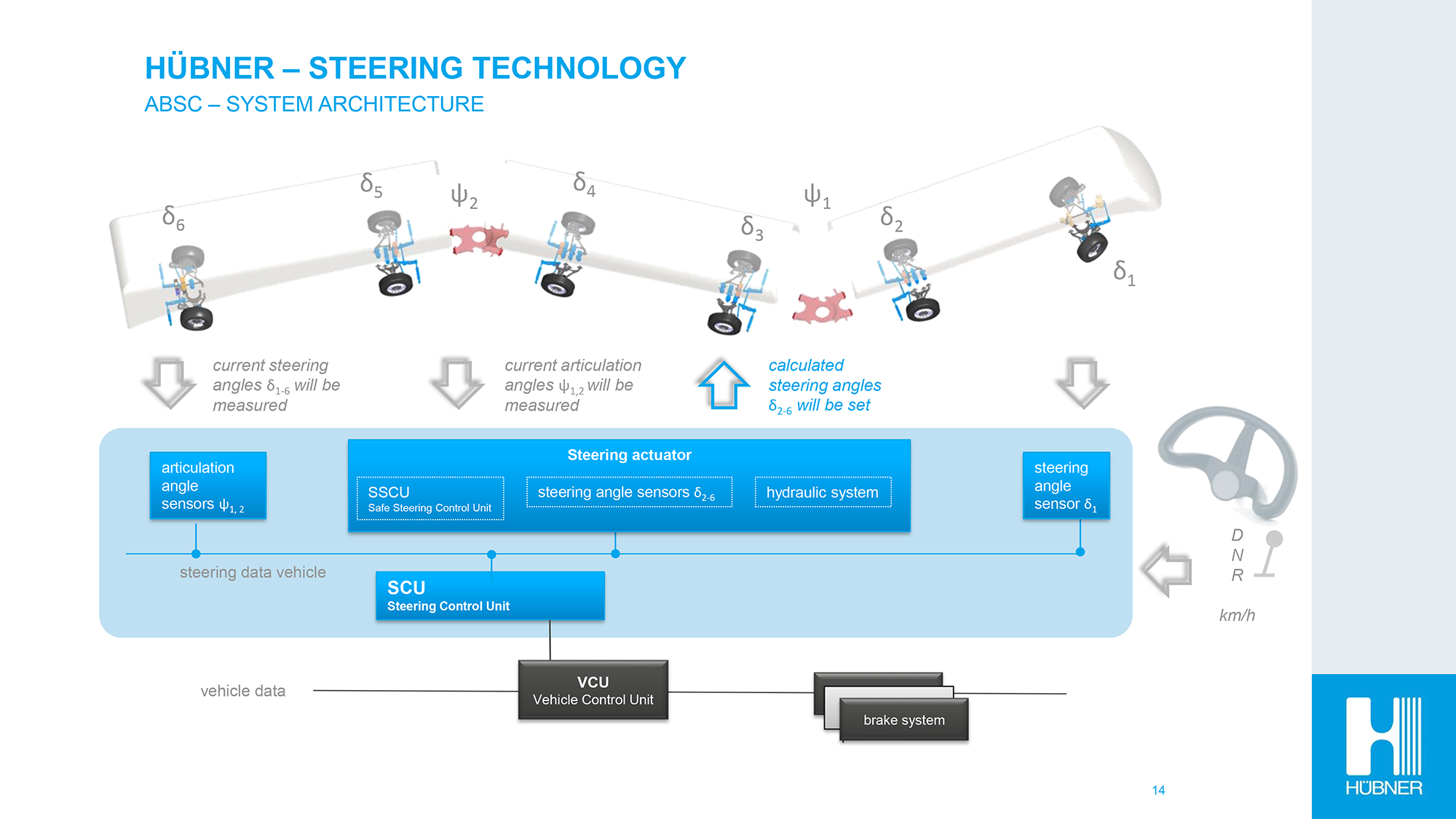
Hübner ABSC Steering System Architecture
Safety, steer-by-wire and autonomy
The Steering Control Unit operates in accordance with the ISO standard 26262, which is the safety standard for the function of electric-electronic systems in the automotive industry since January 2021. This is very critical for safety, stated Bittroff, because, if one axle is not steering in the right direction there could be a safety issue. The safety standard is on the same level as in an airplane, added Bittroff. Furthermore, another key safety feature is that each steering system or module itself has its own fail safe package to ensure there is no operational failure.
The module is steer-by-wire ready, and while it is not necessary for driving in one direction, Bittroff stated, it is necessary for bi-directional applications.
It is also ready for use in combination with autonomous steering systems, as the "steer-by-wire" interface has already been integrated into the new ABSC system.
To make it as flexible as possible, the Hübner steering control system is offered as modules with additional axles and modules being added if the bus length needs to be extended. Below is a picture of the test rig in Dresden of the multi-axle steering system modules with the Hübner components coloured blue. This test rig will move to VSE (a subsidiary of Hübner since 2021) in the Netherlands, which is now responsible for the electronic control steering systems.
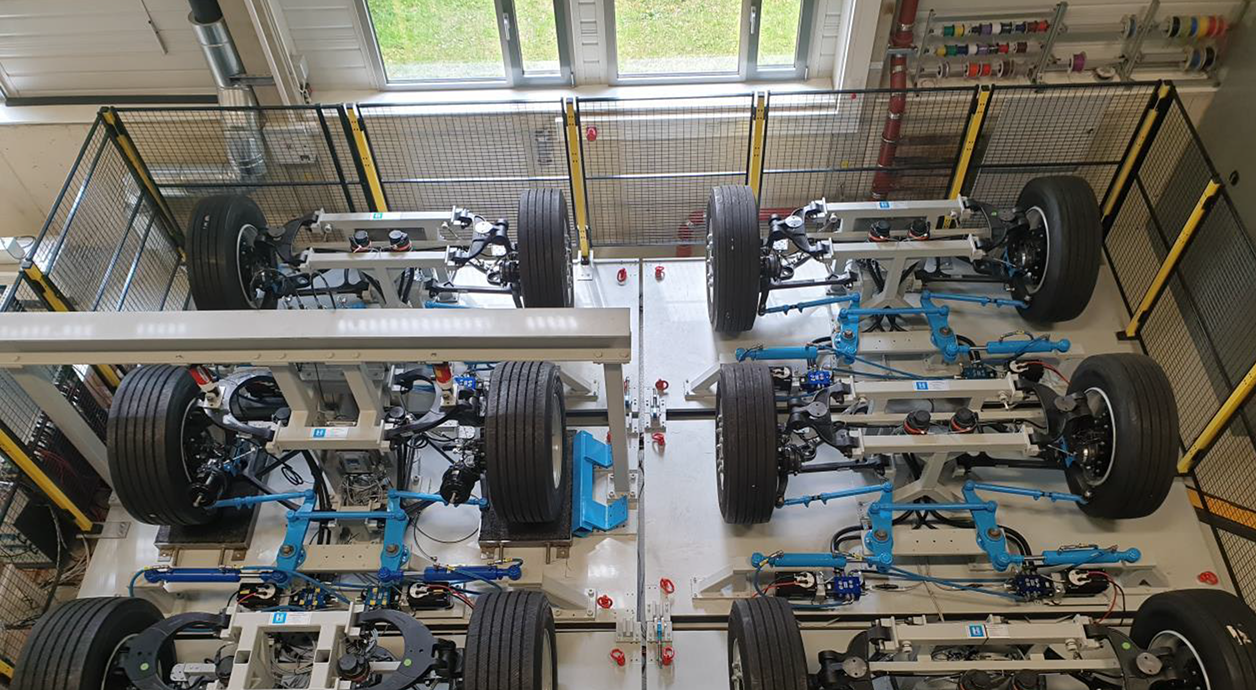
Hübner Test Rig Multi Axle Steering System
The final step of the development project was the ‘fail-safe’ systems in the Hübner ABSC system – i.e., compliance with ISO 26262 standards for the functional safety of electric-electronic systems required for series production vehicles. This work has now been achieved and so the system is ready to go, stated Hübner.
Hübner to launch modular steering system for HCBs at Innotrans 2022
Following five intense years of development, Hübner said it will officially launch its ABSC steering system in Berlin at Innotrans on September 20-23. “Hübner is offering the system as a modular solution – a combination of the company’s proven articulation systems together with a consulting service to assist with the realization of the basic vehicle design. In this way it will be possible in future for customers to implement the new vehicle concepts quickly and economically and be in the position to meet the changing demands of transport markets.”
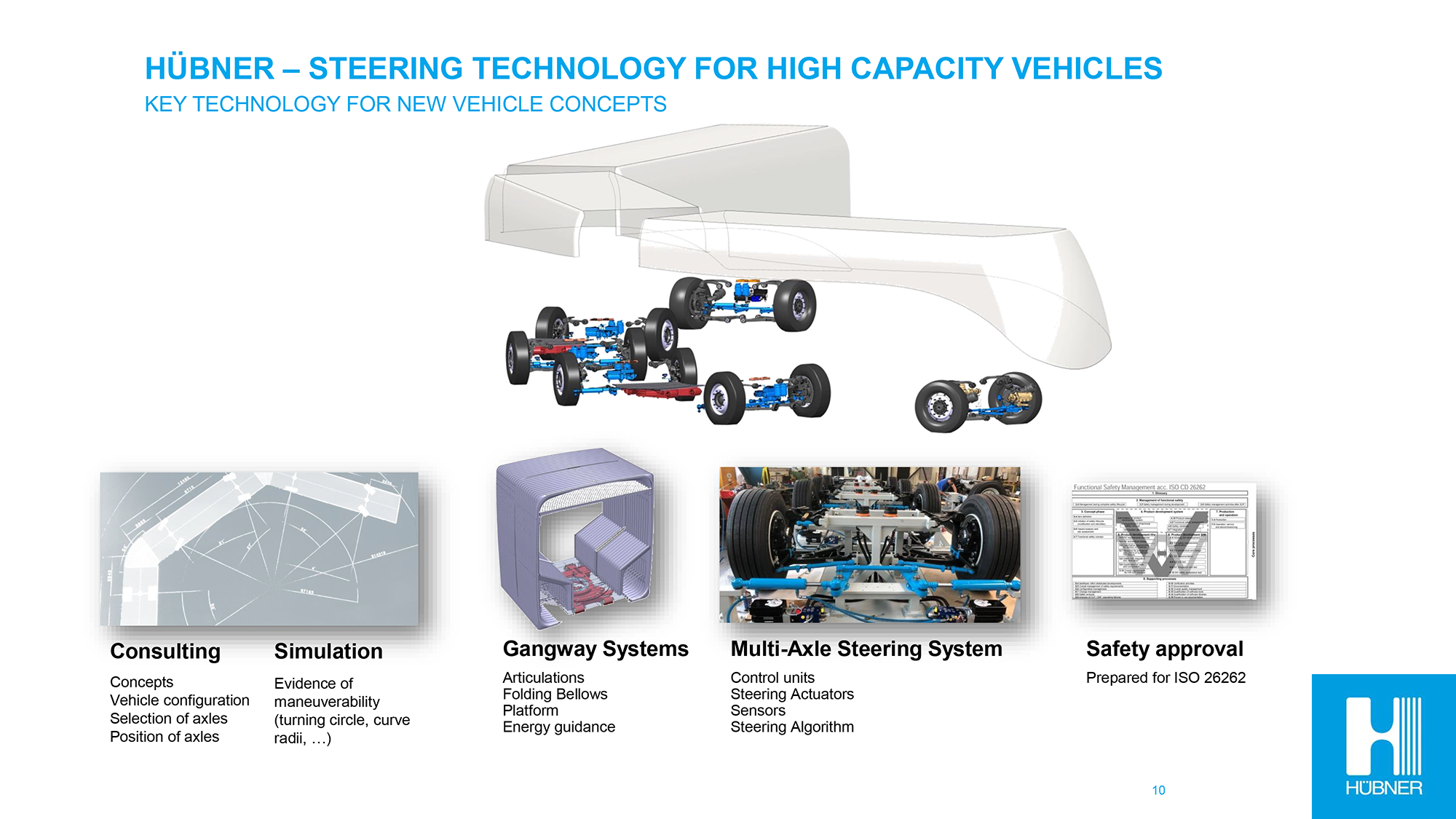
Hübner Steering Technology & Services for development of High Capacity Buses
Market research at the start of the project revealed that many of the electric axles were in high floor buses. However, Hübner has a close relationship with Brist Axle, as it had a steered driven low floor axle that Hübner has used to develop its steering system for low floor high capacity buses. So, the HCB steering system is truly floor height agnostic.
Market perspective
Initially, Hübner saw an opportunity mainly in South America, where there is already demand for high capacity buses, where some of the largest BRT systems exist in the world today. In Turkey, there is also a real need for higher and higher capacity buses; particularly in Istanbul, where they already have a five-axle BRT bi-articulated bus from AKIA. Istanbul possibly would be interested in the Hübner HCB steering system because it can be introduced easily to an existing BRT system and add significantly to the capacity of the network. Bittroff indicated that it is in discussions with one partner that is interested in building a first bus soon and that the focus would be on Turkey.
Other potential markets include China and South America, as well as in parts of Europe, possibly Germany, indicated Bittroff. In Colombia, in Medellin, for example, where topography is an issue and light railway development is restricted by extreme gradients (hilly terrain), a high capacity bus could offer a solution. In Germany, some cities would possibly look at the HCB to extend their infrastructure into the suburbs.
Hübner sees this technology as truly game changing as it is now able to offer its partners the possibility to realize vehicles that economically join the advantages of the bus and the tram and introduce a new dimension in passenger transport.
*Other main project partners include Mobile Electronik GmbH, Brist Axle and VSE.
Mobile Electronik of Langenbrettach, Germany, has been involved in producing mobile electronic - hydraulic rear power steering (EHLA - Elektronisch-Hydraulische Lenk-Anlage) systems since 1972 offering today a broad range of solutions for the steering of rear axles in commercial vehicles and trailers.
Brist Axle Srl of Montichiari, builds a range of mechanical and electrical axles for the bus and truck industry.
V.S.E. Vehicle Systems Engineering B.V. of Veenendaal, Netherlands, which was acquired by Hübner in January 2021 (announced May 2021), develops and supplies electrohydraulic steering and suspension systems for the vehicle industry.
1Fraunhofer Institute for Transport and Infrastructure Systems IVI – Initially, Fraunhofer was the partner for developing algorithms for steering systems. Today, Fraunhofer’s role is in supporting Hübner by helping to further develop the algorithms and in providing simulations for future projects.



